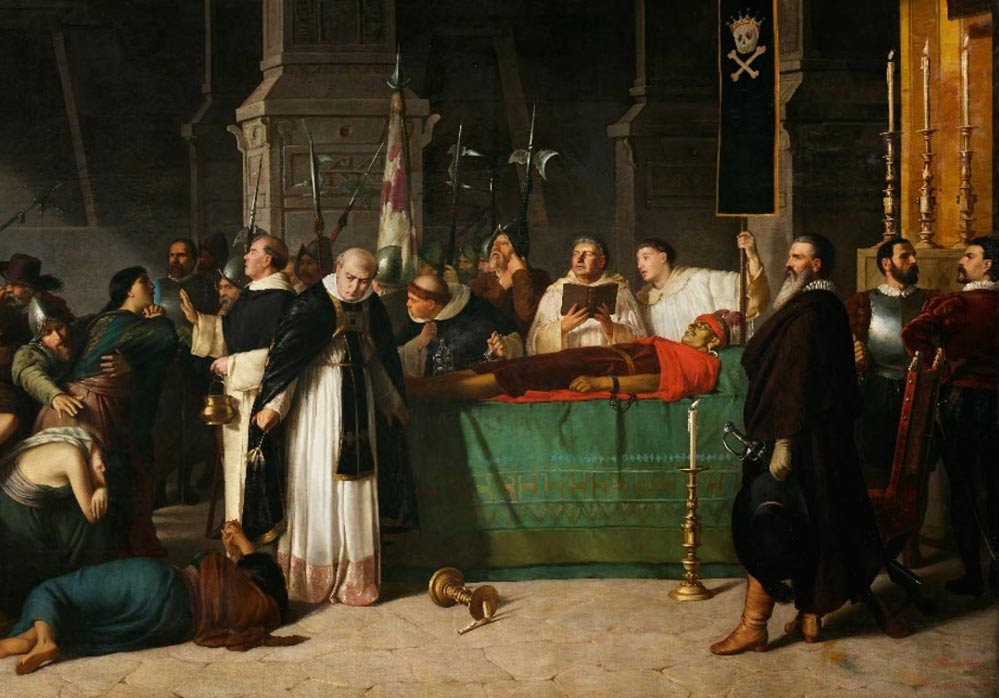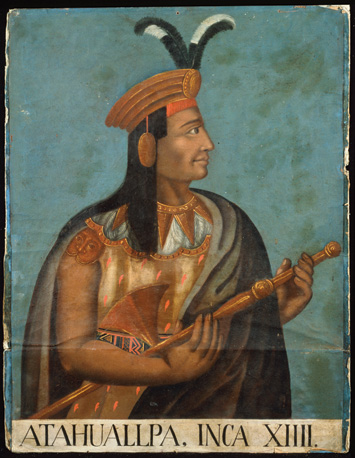New Finds about the Inca Atahualpa

Atahualpa was, if anything, an enigma. Born of a compromise between the warring empires of the Cara Quitus and Sapa Inca.
After a bloody battle in which the King Quito was killed, his daughter, Paccha Duchicela Shyris XVI became queen. Rather than continue the fighting, Huayna Capac asked to marry her, joining their kingdoms. She agreed with the stipulation that their son would be crowned King of Quito on the death of Huayna Capac. His rule was not accepted by the other Inca and civil war as well as continued conquest for the Inca occupied Atahualpa. He had sustained several injuries, including the loss of an ear and a leg injury, but he continued to advance upon Cusco, despite the warning of the Huaca, Catequil. Intent upon taking the Inca capital Cuzco and thereby claiming the throne, he ignored reports of strange people in the land. He was seized by Pizarro and his men. “Legend has it that Atahualpa offered to fill a room with gold and silver in exchange for his release, but Pizarro had him executed in 1533. The Spanish gave Atahualpa a Christian burial in Cajamarca, but numerous accounts suggest his body was exhumed by his followers and mummified.” (Reference)

Tamara Estupiñán, Ecuadorian historian of the French Institute of Andean Studies, has been working for almost two decades, poring over the records of the time, believing that she would find the treasure of the Inca, not in the mountains of the Andes, but in the books. She believes she has found evidence that Rumiñahui, Atahualpa’s general, took the bones of the last Inca Emperor, and hid them near Quito, Ecuador.
It is still rumored that Pizarro had demanded a room full of gold in exchange for Atahualpa’s release, and that the impatient Spaniard garroted the ruler before the ransom coming from Ecuador ever arrived. There is no record of such a contract, however. It was supposed that treasure was collected, but never arrived, as the news of the dead emperor reached the ears of the carriers before they came to the city. For centuries, gold diggers, archeologists, and others have searched the mountains of Ecuador for the treasure destined to stave an execution and save an emperor.(Reference)

However, Tamara Estupiñán believes that the treasure is not the gold, but the bones of the Emperor. “For a new Incan king to be crowned, she explains, the ceremony had to take place in front of the mummy of his predecessor. For the [Incas] the real treasure was Atahualpa’s body,” she continued. “Without a mummy, there is no coronation. Without a body, there is nothing — it’s as simple as that.”

Estupiñán had believed that the secrets were held in such mundane texts as the land holding documents of the son of Atahualpa. She took over a year to painstakingly translate and decipher the seven page document. In those pages, she found intersects between the land holdings and the travels of the general Rumiñahui, and both pointed to Sigchos, a place not far from Quito. “Working on a hunch, Estupiñan began researching Incan death rituals and discovered that a ruler’s mummy was referred to as a malqui. And, sure enough, there was an area called Malqui near Sigchos” (Ibid).
Studying old maps, she also found Machay, which means ‘final resting place.’ (Reference)
Traveling to the area in 2010, in the dense jungle she found Inca-like stonework which was subsequently named Malqui-Machay. According to Ecuador.com, “It consists of a complex of walls, stonework and aqueducts in the distinctive style of imperial Inca design, with a monument leading to several rectangular rooms constructed out of cut and polished stone surrounding a plaza. The incredibly well preserved structure includes a walled walkway beginning at the Machay River, with pyramid-styled stairs leading to what would have been the emperor’s throne.” (Reference)

Estupiñán is convinced that this is the final resting place of the last emperor of the Incas. However, she is afraid that the bones of Atahualpa, which would have been displayed out in the open, will have been given over to time. “This mystery is a puzzle, and I have 70 to 80 percent of the pieces,” she said. “I’m still missing 30 percent of the puzzle — and in that 30 percent, is the body.”
Read more here: (Reference)




